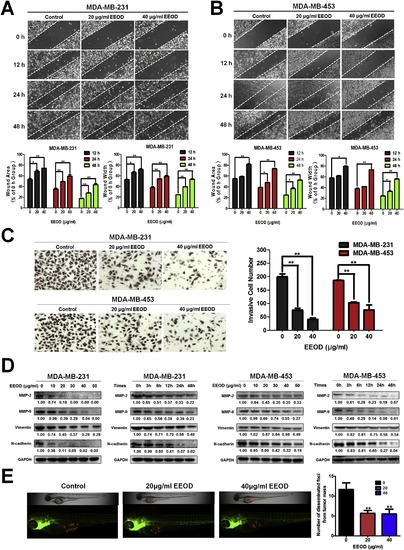- Title
-
Network-pharmacology-based identification of caveolin-1 as a key target of Oldenlandia diffusa to suppress breast cancer metastasis
- Authors
- Yang, B., Wang, N., Wang, S., Li, X., Zheng, Y., Li, M., Song, J., Zhang, F., Mei, W., Lin, Y., Wang, Z.
- Source
- Full text @ Biomed. Pharmacother.
|
EEOD suppressed migration and invasion of high-metastatic breast cancer cell lines MDA-MB-231 and MDA-MB-453. (A–B) Wound healing assay demonstrated that EEOD treatment could remarkably decrease the healing area and migration distance of both MDA-MB-231 and MDA-MB-453 cells. The histogram (below) is the quantitative analysis of the healing area and migration distance (up). (40×). (C) Transwell assay indicated that EEOD could decrease the invasive cell number of both MDA-MB-231 and MDA-MB-453 cells. The histogram (right) is the quantitative analysis of the invasive cell number (left). (200×). (D) EEOD treatment (0–50 μg/ml) could dramatically attenuate the expression of multiple metastasis-related proteins in both MDA-MB-231 and MDA-MB-453 cells in a time-concentration dependent manner, including MMP2, MMP9, N-cadherin and vimentin. (E) EEOD at concentrations from 20 μg/ml to 40 μg/ml significantly decreased the number of disseminated tumor foci in the zebrafish body when compared with control group. *p < 0.05, **p < 0.01. |

